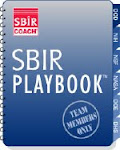Companies that win SBIR awards, and get funding for demonstrating feasibility (Phase I) and developing the proof-of-concept prototype (Phase II) often find themselves stymied to take the technology further. Funding for commercialization (Phase III) is very hard to arrange and obtain -- it isn't provided via the required agency R&D budget set-aside as is Phase I and II. The "normal" processes for getting such projects funded are just too daunting and competitive for most small businesses to undertake. But there's actually many sources of help, some new, and some not so new.
About seven years ago I received the distinct honor of being invited to join a distinguished national Panel of experts on small business technology development and commercialization. This Panel is convened several times a year by the Washington Office of the National Technology Transfer Center (NTTC) for the purpose of advising businesses (both large and small) and research institutions (both universities and Federal labs) who are conducting research and development funded by the DOD's Missile Defense Agency (MDA). The advice is specifically focused on issues relating to the transitioning of their technology to end use, and, hopefully, eventual insertion into MDA systems.
MDA has sponsored and NTTC has administered this enlightened Technology Applications Review (TAR) program for over twenty years (I'm still one of the newbies). The invited companies present the status of their MDA funded technology development progress, their plans for transitioning it to commercialization, and their assessment of the resources they'll need to accomplish the plans. History shows that the majority of these TAR participants have been SBIR-funded small businesses, usually at the level of Phase II. The Panel provides critical feedback on their plans, and offers suggestions for new strategic business positioning, tactical approaches for implementing the plans, new ideas for applications of the technology, and referrals to individuals to contact for further guidance and help.
Well, the NTTC convened our third TAR meeting of 2008 last week in San Diego. Four very interesting SBIR companies made their presentations, and we on the Panel provided much spirited feedback. The company executives all went away with "to do" lists of actions to be taken, some strategic, some tactical. Two of the companies were actually making a repeat TAR appearance, having been so impressed with the quality of the advice they had received in their prior visit that they were back for another dose of reality. We'll have another session next week in Washington DC with five more SBIR companies making presentations. I can hardly wait!
While the NTTC/MDA sponsored TAR is, in my opinion, the most focused and, arguably, the best support mechanism out there for promoting transitioning of an SBIR company to commercialization success, there are other initiatives for companies who are not MDA funded to take advantage of. The DOD began what's known as the Commercialization Pilot Program (CPP) back in 2006. It's evolving and still pretty "new". It's been implemented by the Army, Navy, and Air Force, to provide direct support to smooth the way for SBIR companies to obtain Phase III funding for commercialization. Support is available via the CPP for a variety of business functions, as well as for removing roadblocks to working with Defense Prime Contractors.
The Army, Navy, Air Force, and the MDA, themselves hold regular events designed to promote commercialization of small business developed technologies, many of which focus on SBIR. Just today I received notice of a conference on transitioning "disruptive" technologies from "non-traditional" sources (e.g., small SBIR companies) to the Army's ARDEC. The event will be held next January. Click HERE for more information. In future Blog posts I'll take a close look at what each of the Federal agencies (all of them - not just DOD) are doing (or, in some cases, not doing) to promote Phase III.
And, finally, the SBIR re-authorization legislation will very likely provide some funding for more Phase III support for all of the agencies, as well as the requirement to actively support the transition of SBIR technology to commercialization. All the more reason for us to get behind the effort to convince our legislators to do this right.
___________________
PS: 11/3/08. I sent out an SBIR Coach's Newsletter issue today that answers the question: What is Phase III? If you're at all confused about that, you'll want to read this. If you'd like a copy, please write to me. To get on the Newsletter mailing list, click the button on the margin at the left (be sure to answer the confirming email you'll get). Every issue has opt-out buttons, and your email address privacy is strictly guaranteed.
.
Wednesday, October 29, 2008
New Help for Transitioning SBIR-Funded Technology to Commercialization (Phase III)
Subscribe to:
Post Comments (Atom)





 Join Email List
Join Email List




1 comment:
Excellent article on some promising commercilization programs Fred! Look forward to hearing more.
Post a Comment